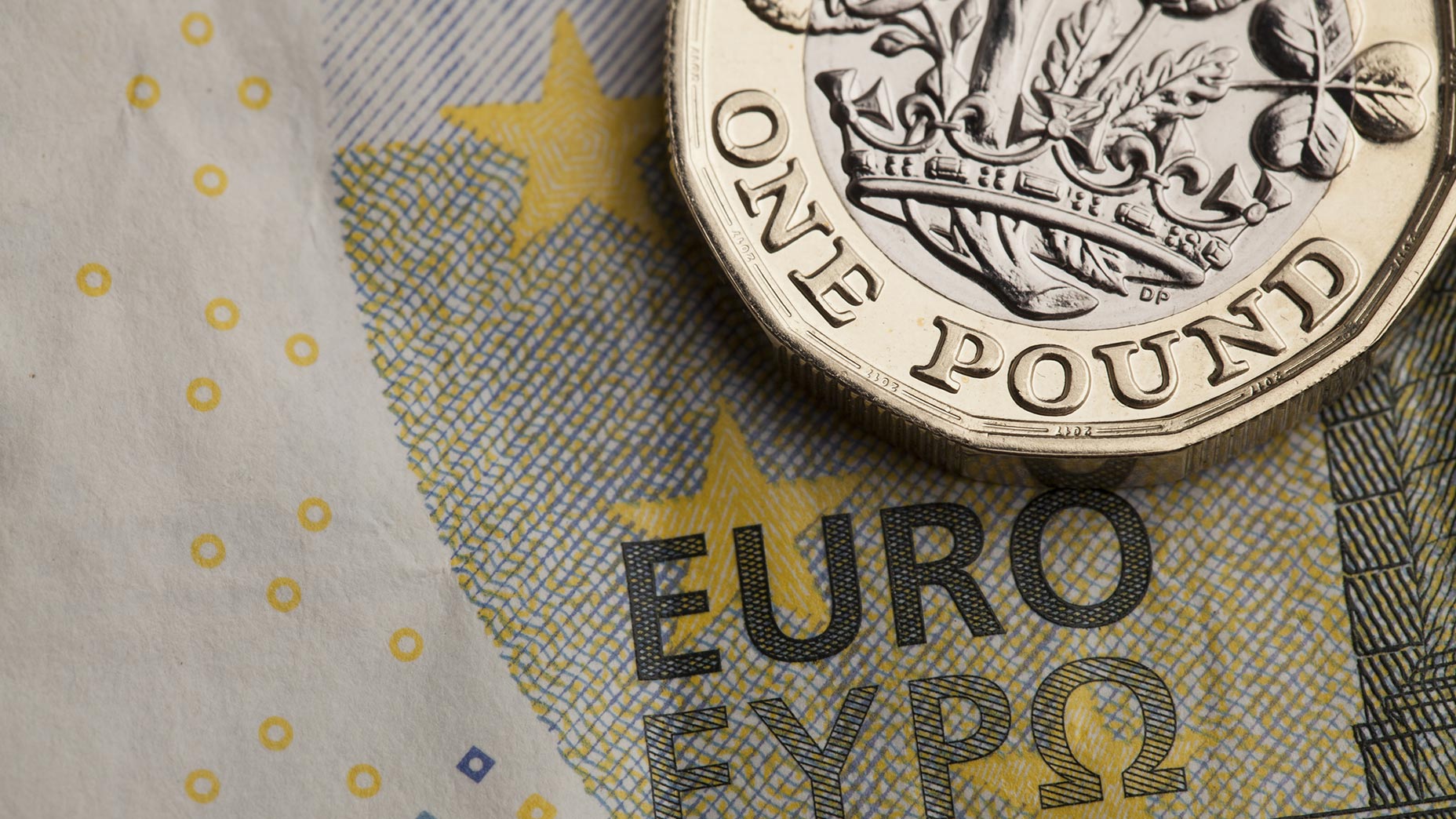EUR/GBP 2024 Forecast: Analysis and Expert Predictions

9 minutes for reading
Today, on 19 December 2023, we will examine the key factors influencing the exchange rate of the EUR/GBP pair, which is in high demand in the international foreign exchange market. We will also analyse its performance in 2023 and explore experts’ forecasts for its 2024 outlook.
You can visit the RoboForex Market Analysis webpage for the latest forex forecasts.
In-depth analysis of the EUR/GBP currency pair
The EUR/GBP pair is the cross rate of the two popular currency pairs, EUR/USD and GBP/USD. A cross rate is the price of one country’s currency expressed in another country’s currency and determined through their values against a third currency – the US dollar, traditionally considered the primary international reserve currency.
The EUR/GBP exchange rate reflects the dynamics of the value of the common European currency (EUR) against the British pound sterling (GBP). In this pair, the euro is the base currency, and the current price reflects how many pounds are needed to buy or sell one euro. When the pair’s quotes go up, it indicates a strengthening euro, and when they drop, it signifies a weakening euro against the UK currency.
Trading characteristics of the EUR/GBP pair
- The pair is traded round the clock from Monday to Friday inclusive, with the highest activity observed during the European and American trading sessions
- The EUR/GBP pair shows a low average daily volatility of approximately 500 pips
- Thanks to its popularity, high liquidity, and moderate volatility, the spread for this pair is minimal, ranging from 3 to 5 pips in a quiet market
Critical factors influencing the EUR/GBP pair in 2024
The role of the Bank of England’s monetary policy
The primary tool the UK central bank uses to regulate inflation and influence the exchange rate of the national currency is the implementation of changes in the key interest rate. If the interest rate increases, the pound sterling exchange rate strengthens against other currencies, while a decrease in the interest rate leads to a decline in the exchange rate. Since December 2021, the Bank of England has executed a series of interest rate hikes to curb high inflation.
The rate increased from 0.1% to 5.25% during this period. The Bank of England’s Monetary Policy Committee aims to achieve a 2% inflation target. Thanks to interest rate increases, inflation rates are slowing down in the second half of 2023, with the regulator pausing its interest rate hikes since August. While consumer inflation fell from 10.5% in January to 4.6% in November, it is still above the central bank’s target.
Further actions on interest rate changes in 2024 will depend on economic data, primarily on inflation rates. If the UK’s GDP declines and recession signs emerge, this may negatively impact the pound exchange rate, with the EUR/GBP pair receiving support for growth. Conversely, strong GDP growth and high inflation might prompt the regulator to raise the interest rate again, bolstering the pound sterling against the euro.
EU monetary policy and its effects on EUR/GBP
The European Central Bank’s monetary policy strongly impacts the EUR/GBP pair. For example, interest rate hikes in the eurozone contribute to strengthening the euro exchange rate against the pound. The regulator has been implementing a series of tightening measures in its monetary policy since July 2022 to curb rapidly rising inflation. During this period, the interest rate increased from 0% to 4.5%, with the latest (at the time of writing) hike of 0.25% in September 2023.
Consumer inflation in the eurozone is exhibiting signs of a slowdown in 2023: while the rate reached 10.1% in January, growth in November was just 2.4%. The ECB focuses on attaining a 2% inflation target. The regulator is currently pausing its interest rate hike series in response to slowing European inflation rates.
The central bank will need some time to assess further inflation dynamics. The regulator currently believes that inflation in the eurozone may remain at 3% in 2024 and, therefore, does not rush to fully complete policy tightening. This decision can support the EUR/GBP quotes at present, but once the central bank’s comments change and refer to a possible rate reduction, they may come under pressure.
EU and UK economic indicators
- Monetary policies of the European Central Bank and the Bank of England: changes in interest rates, QE, and QT programmes
- Political events in the EU and the UK
- Unemployment Rate
- GDP Growth Rates (GDP)
- Inflation Indices (CPI, PPI)
- Industrial Production Index
- Retail Sales
- Trade Balance
- Economic Sentiment Indices for the eurozone (ZEW, IFO)
2023 EUR/GBP exchange rate review
The EUR/GBP pair shows mixed dynamics in 2023, trading within a wide sideways range, with the upper boundary set in February at 0.8980. Subsequently, the pair smoothly declined, forming a lower boundary at 0.8500 in July-August. At the time of writing, the pair’s quotes demonstrate a moderate upward movement on the daily chart.
EUR/GBP currency pair chart*
Technical analysis and predictions for EUR/GBP in 2024
After rebounding from the annual low of 0.8500 in July-August 2023, the EUR/GBP currency pair is experiencing upward momentum within an ascending local price channel on the daily chart. At the time of writing, the pair underwent a downward correction towards the channel’s lower boundary, forming a local support level at 0.8550.
If this support level does not break, the pair will likely continue its upward movement to the upper boundary of the ascending channel at 0.8800. Should the quotes fall below 0.8550, the ascending scenario will probably be cancelled, with the price potentially declining to the annual low of 0.8500 and further to 0.8350. The SMA (200) and Alligator indicators suggest a local downward impulse of the price movement.
Expert opinions and EUR/GBP analyst predictions for 2024
- ING Group specialists forecast that the EUR/GBP exchange rate will strengthen to 0.8900 by mid-2024 and to 0.9000 by the end of 2024
- The Economy Forecast Agency (EFA) analysts suggest that the currency pair’s exchange rate will reach 0.8800 by mid-2024 and 0.8530 by the end of 2024
- Wallet Investor experts expect the pair’s quotes to drop to 0.8510 by mid-2024, ending next year at 0.8570
Conclusion: navigating the EUR/GBP market in 2024
The EUR/GBP currency pair is declining moderately in 2023, falling from its early year high of 0.8980 to 0.8600 by 19 December. Both the UK and eurozone central banks are implementing a monetary policy tightening cycle to alleviate mounting inflationary pressure. Currently, both regulators are on pause, assessing the impact of interest rate hikes on the economy. At the time of writing, the interest rates stand at 5.25% and 4.5%, respectively.
The key factor influencing further movement in the EUR/GBP pair in 2024 will likely be the EU and the UK’s economic indicators and inflation rates. The central banks may decide to end the monetary policy tightening cycle or lower the rates depending on the incoming statistics. If the Bank of England is the first to announce its plans to reduce the interest rate, the pair will likely receive support for growth. If the ECB takes the initiative, the pair’s exchange rate may come under pressure.
FAQ on EUR/GBP forecast and trading strategies
What are the major factors influencing the EUR/GBP exchange rate?
Various factors, including the monetary policies of the European Central Bank and the Bank of England, economic indicators such as GDP growth, inflation rates, political events in the EU and UK, and global economic trends influence the EUR/GBP exchange rate.
How does Brexit continue to impact the EUR/GBP currency pair?
Brexit has a lingering impact on the EUR/GBP pair, mainly through trade relations between the EU and the UK, regulatory changes, and investor confidence. These factors can cause volatility and are crucial in forecasting future trends.
What role does technical analysis play in forecasting EUR/GBP trends?
Technical analysis involves studying historical price patterns and trends to forecast future currency movements. It’s a critical tool for traders, providing insights into potential resistance and support levels, trend reversals, and momentum in the EUR/GBP market.
Can economic events in the EU significantly affect the EUR/GBP rate?
Significant economic events in the EU, such as changes in interest rates, fiscal policies, or political upheaval, can profoundly affect the EUR/GBP rate by altering investor sentiment and economic stability.
How should traders prepare for volatility in the EUR/GBP pair?
Traders should stay informed about key economic indicators and news, use risk management strategies like stop-loss orders, and consider diversifying their investment portfolio to mitigate risks associated with volatility.
What are some reliable sources for EUR/GBP forecasts and analysis?
Reliable sources include financial news websites, reports from central banks, economic analyses from reputable financial institutions, and updates from forex trading platforms.
How accurate are short-term vs. long-term EUR/GBP forecasts?
Short-term forecasts are generally more accurate than long-term projections due to the predictability of immediate events. In contrast, long-term forecasts can be subject to more significant uncertainty due to unforeseen economic, political, or global factors.
What impact does the USD have on the EUR/GBP currency pair?
The USD can indirectly impact the EUR/GBP, a significant currency pair in global forex markets. Movements in the USD can influence investor sentiment and capital flows between the euro, pound, and dollar.
Can geopolitical events outside the EU and UK affect the EUR/GBP pair?
Global geopolitical events can affect the EUR/GBP pair by influencing market sentiment, global economic stability, and investor risk appetite.
What are some common mistakes to avoid in EUR/GBP forex trading?
Common mistakes include overleveraging, ignoring economic indicators and news, lack of a trading plan, and failing to use risk management tools.
* – The charts featured in this article originate from the TradingView platform, renowned for its extensive set of tools designed for financial market analysis. Functioning as a user-friendly and advanced online market data charting service, TradingView allows users to perform technical analysis, explore financial data, and connect with fellow traders and investors. Furthermore, it offers valuable guidance on effectively understanding how to read forex economic calendar, in addition to providing insights into various other financial assets.















